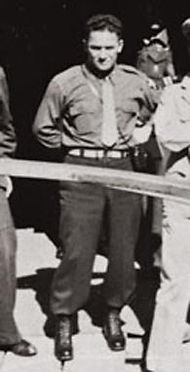Stephen Kovalyak (1915-1997)

Stephen Kovalyak was born in Anita, Pennsylvania on August 19, 1915, a descendant of a family of successful Czechoslovakian immigrants who settled in Pennsylvania. He attended Clarion State Teacher’s College (today, Clarion University), where he studied English and Social Studies.
Kovalyak enlisted in the U.S. Army in August 1942 and was commissioned in the Second Infantry Division the following March. In early 1945 he was transferred to the MFAA to assist in evacuations at the Bernterode salt mine in Thuringia, Germany. While he possessed no expertise in art history or the conservation of cultural objects, Kovalyak was highly valued for his knowledge of Slavic dialects as well as his physical strength. Monuments Man Capt. Walker K. Hancock later remarked that Kovalyak “must have been a wrestler, for he looked and moved like a formidable one.”
At Bernterode, Kovalyak was involved in “Operation Bodysnatch,” a closely-guarded secret mission to evacuate the remains of President and Frau von Hindenburg, Frederick the Great of Prussia, and Frederick’s father, Frederick Wilhelm I. The four elaborately decorated caskets, along with other royal treasures, had been secreted away in the mine on orders from Adolf Hitler, who intended to resurrect them as symbols of a Fourth Reich. Monuments Men Lt. Cdr. George L. Stout and Capt. Hancock led the removal operation. Impressed by Kovalyak’s resourcefulness, Lt. Cdr. Stout took him under his wing. In the coming year, Kovalyak was involved in some of the most significant recovery missions of the MFAA. He regularly assisted Monuments Men Lt. Cdr. Thomas C. Howe, Lt. Lamont Moore, and Lt. Frederick Shrady with evacuations at the salt mine in Altaussee, Austria, where the Nazis had hidden Michelangelo’s Bruges Madonna, Vermeer’s The Artist’s Studio, and the Ghent Altarpiece by Jan van Eyck. All told, the complete evacuation of the mine required five weeks of hard work and yielded ninety truckloads of looted works of art, furniture, and other cultural objects.
Because of their success at Altaussee, Howe, Moore, and Kovalyak were appointed as a three-man Special Evacuation Team under the authority of the U.S. Forces European Theater (USFET). The team’s first official assignment took them to Berchtesgaden, Germany, where they spent three weeks evacuating to the Munich Central Collecting Point thirty-one truckloads of looted items belonging to the collection of Nazi Reichsmarshall Hermann Goering. An even more difficult assignment followed at the Castle of Neuschwanstein in the Bavarian Alps, where they were tasked with removing the records of the Einsatzstab Reichsleiter Rosenberg (ERR, the Nazi art looting organization which looted works of art for Hitler’s planned Führermuseum in Linz, Austria). Consisting of over 20,000 catalogue cards of looted works of art, 8,000 negatives, and piles of documents, the records were crucial to the restitution of thousands of looted items. In September 1945 the team travelled to Nuremberg, Germany, where they inspected the Veit Stoss Altarpiece in preparation for its return to Cracow, Poland. In their report, they estimated that the important shipment would require eight trucks, two armed escort jeeps, and three additional packers.
Kovalyak was discharged in March 1946 and returned to Pennsylvania. He gave lectures at Clarion College before beginning a career with the Pennsylvania Department of Education, which spanned more than twenty years. Kovalyak traveled to public schools throughout the state, conducting inspections of teaching facilities and advising on improvements which benefited thousands of young students.
Stephen Kovalyak died in Brookville, Pennsylvania on March 1, 1997.

.png)